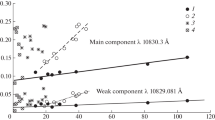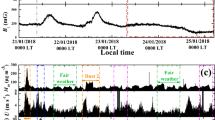Summary
Concentration (by number) of magnetic spheroids recorded in 1967, 1969, and 1971 in the Northern and Southern Hemisphere at different longitudes and latitudes during the month of October may be associated with the formation of the ozone hole in the ozone layer during September and the first part of October. The flux of magnetic spheroids was found to increase from the North toward the South thus providing sufficient concentrations of particles around the South Pole capable of reacting chemically with ozone. The surfaces of magnetic spheroids consisted of FeO1.3 and sub-surfaces of FeO1.1 indicating that oxidation proceeded from the outside inward. The ozone hole in October in the Southern Hemisphere may be a natural phenomenon.
Similar content being viewed by others
References
Farman J. C., Gardiner B. G. andShanklin J. D.,Nature,315 (1985) 207.
Stratospheric ozone. The state of the science and NOAA's current and future research (U.S. Department of Commerce, Washington, D.C.) 1990.
J. Geophys. Res.,94 (1989) A1-D15.
Findeisen W.,Meteorol. Z.,55 (1938) 121.
Bowen E. G.,Austral. J. Phys.,6 (1953) 490.
Bowen E. G.,J. Meteorol.13 (1956) 142.
Rosinski J. andSnow R. H.,J. Meteorol.,18 (1961) 736.
Rosinski J.,J. Atmos. Terr. Phys.,32 (1970) 805.
Rosinski J. andPierrard J.,J. Atmos. Terr. Phys.,24 (1962) 1017.
Dzienis B. andKopcewicz M.,Tellus,25 (1973) 213.
Kopcewicz B. andKopcewicz M.,Tellus,30, (1978) 562.
Schmidt R. A., NASA Tech. Note No. D-2719 (Washington, D.C.) 1965.
Nagamoto C. T. andRosinski J.,J. Atmos. Terr. Phys.,33, (1971) 1559.
Rosinski J., Nagamoto C. T. andKerrigan T. C.,J. Atmos. Terr. Phys.,35 (1973) 95.
Rosinski J. andPierrard J.,J. Atmos. Terr. Phys.,26 (1964) 51.
Rosinski J.,J. Atmos. Terr. Phys.,34 (1972) 487.
Rosinski J., Nagamoto C. T. andBayard M.,J. Atmos. Terr. Phys.,37, (1975) 1231.
Rosinski J., Nagamoto C. T., Langer G. andParungo F. P.,J. Geophys. Res.,75 (1970) 2961.
Kruger A. J. andMinzner R. A.,J. Geophys. Res.,81 (1976) 4477.
Handbook of Geophysics (The Macmillan Co., New York, N.Y.) 1961.
Stolarski R. S.,Change in ozone over the Antarctic, inThe Changing Atmosphere (Wiley-Interscience Publ.) 1988.
Author information
Authors and Affiliations
Additional information
The National Center for Atmospheric Research is sponsored by the National Science Foundation.
Rights and permissions
About this article
Cite this article
Rosinski, J. On the ozone hole in October. Il Nuovo Cimento C 19, 417–426 (1996). https://doi.org/10.1007/BF02509299
Received:
Accepted:
Issue Date:
DOI: https://doi.org/10.1007/BF02509299




